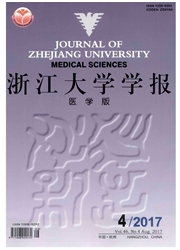

 中文摘要:
中文摘要:
目的:通过比较苯并芘对ADP、胶原和凝血酶三种刺激剂诱导血小板聚集和P-选择素表达的影响,探讨苯并芘对血小板活化的作用。方法:抽取健康志愿者静脉血液20 ml,采用聚集仪检测血小板在苯并芘和不同刺激剂下的聚集率,并用流式细胞仪检测血小板表面P-选择素的表达情况。结果:10μmol/L、1μmol/L和0.1μmol/L苯并芘均不能引起血小板聚集,经10μmol/L苯并芘孵育血小板后,在胶原和凝血酶的刺激下也不能增强血小板的聚集。但是,经苯并芘孵育后的血小板在ADP的刺激下聚集率达到(80±10)%,与未经苯并芘孵育的血小板相比差异有统计学意义(P<0.01)。流式细胞仪检测P-选择素的表达结果显示苯并芘孵育后的血小板能在ADP诱导下P-选择素表达增强(P<0.01),而凝血酶则不能引起该改变。结论:苯并芘刺激ADP诱导的血小板聚集和P-选择素表达增强很大程度上是通过ADP介导的信号通路。
 英文摘要:
英文摘要:
Objective: To investigate the effect of benzo(a)pyrene(BaP) on platelet aggregation and expression of P-selectin.Methods: Blood samples were collected from healthy volunteers and the platelets was washed.Platelet aggregation was monitored by aggregometer and the expression of P-seletin was detected by whole blood flow cytometry.Results: BaP(10 μmol/L,1 μmol/L and 0.1 μmol/L) did not induce platelet aggregation;however,preincubation with BaP(10 μmol/L) significantly enhanced ADP-induced platelet aggregation(...
 同期刊论文项目
同期刊论文项目
 同项目期刊论文
同项目期刊论文
 Differences in heating methods may account for variation in reported effects on gammaH2AX focus form
Differences in heating methods may account for variation in reported effects on gammaH2AX focus form Effects of Mycoplasma pneumoniae infection on sphingolipid metabolism in human lung carcinoma A549 c
Effects of Mycoplasma pneumoniae infection on sphingolipid metabolism in human lung carcinoma A549 c 期刊信息
期刊信息
